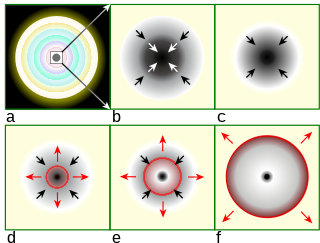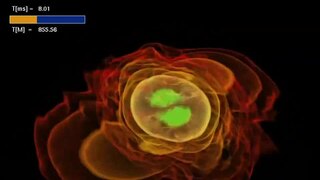The Chandrasekhar limit is the maximum mass of a stable white dwarf star. The currently accepted value of the Chandrasekhar limit is about 1.4 M☉ (2.765×1030 kg).

A star is an astronomical object comprising a luminous spheroid of plasma held together by self-gravity. The nearest star to Earth is the Sun. Many other stars are visible to the naked eye at night, but their immense distances from Earth make them appear as fixed points of light. The most prominent stars have been categorised into constellations and asterisms, and many of the brightest stars have proper names. Astronomers have assembled star catalogues that identify the known stars and provide standardized stellar designations. The observable universe contains an estimated 1022 to 1024 stars. Only about 4,000 of these stars are visible to the naked eye, all within the Milky Way galaxy.

Stellar evolution is the process by which a star changes over the course of time. Depending on the mass of the star, its lifetime can range from a few million years for the most massive to trillions of years for the least massive, which is considerably longer than the current age of the universe. The table shows the lifetimes of stars as a function of their masses. All stars are formed from collapsing clouds of gas and dust, often called nebulae or molecular clouds. Over the course of millions of years, these protostars settle down into a state of equilibrium, becoming what is known as a main-sequence star.
Degenerate matter is a highly dense state of fermionic matter in which the Pauli exclusion principle exerts significant pressure in addition to, or in lieu of, thermal pressure. The description applies to matter composed of electrons, protons, neutrons or other fermions. The term is mainly used in astrophysics to refer to dense stellar objects where gravitational pressure is so extreme that quantum mechanical effects are significant. This type of matter is naturally found in stars in their final evolutionary states, such as white dwarfs and neutron stars, where thermal pressure alone is not enough to avoid gravitational collapse.
A massive astrophysical compact halo object (MACHO) is a kind of astronomical body that might explain the apparent presence of dark matter in galaxy halos. A MACHO is a body that emits little or no radiation and drifts through interstellar space unassociated with any planetary system. Since MACHOs are not luminous, they are hard to detect. MACHO candidates include black holes or neutron stars as well as brown dwarfs and unassociated planets. White dwarfs and very faint red dwarfs have also been proposed as candidate MACHOs. The term was coined by astrophysicist Kim Griest.
In astronomy, the term compact star refers collectively to white dwarfs, neutron stars, and black holes. It would grow to include exotic stars if such hypothetical, dense bodies are confirmed to exist. All compact objects have a high mass relative to their radius, giving them a very high density, compared to ordinary atomic matter.

A helium flash is a very brief thermal runaway nuclear fusion of large quantities of helium into carbon through the triple-alpha process in the core of low mass stars during their red giant phase. A much rarer runaway helium fusion process can also occur on the surface of accreting white dwarf stars.

Gravitational collapse is the contraction of an astronomical object due to the influence of its own gravity, which tends to draw matter inward toward the center of gravity. Gravitational collapse is a fundamental mechanism for structure formation in the universe. Over time an initial, relatively smooth distribution of matter will collapse to form pockets of higher density, typically creating a hierarchy of condensed structures such as clusters of galaxies, stellar groups, stars and planets.

The Kelvin–Helmholtz mechanism is an astronomical process that occurs when the surface of a star or a planet cools. The cooling causes the internal pressure to drop, and the star or planet shrinks as a result. This compression, in turn, heats the core of the star/planet. This mechanism is evident on Jupiter and Saturn and on brown dwarfs whose central temperatures are not high enough to undergo hydrogen fusion. It is estimated that Jupiter radiates more energy through this mechanism than it receives from the Sun, but Saturn might not. Jupiter has been estimated to shrink at a rate of approximately 1 mm/year by this process, corresponding to an internal flux of 7.485 W/m2.

Thermal runaway describes a process that is accelerated by increased temperature, in turn releasing energy that further increases temperature. Thermal runaway occurs in situations where an increase in temperature changes the conditions in a way that causes a further increase in temperature, often leading to a destructive result. It is a kind of uncontrolled positive feedback.
Supernova nucleosynthesis is the nucleosynthesis of chemical elements in supernova explosions.
Fusor is a proposed term for an astronomical object which is capable of core fusion. The term is more inclusive than "star".

The following outline is provided as an overview of and topical guide to astronomy:

A sub-brown dwarf or planetary-mass brown dwarf is an astronomical object that formed in the same manner as stars and brown dwarfs but that has a planetary mass, therefore by definition below the limiting mass for thermonuclear fusion of deuterium . Some researchers call them rogue planets whereas others call them planetary-mass brown dwarfs. They are sometimes categorized as Y spectral class brown dwarfs.

A Type II supernova results from the rapid collapse and violent explosion of a massive star. A star must have at least eight times, but no more than 40 to 50 times, the mass of the Sun (M☉) to undergo this type of explosion. Type II supernovae are distinguished from other types of supernovae by the presence of hydrogen in their spectra. They are usually observed in the spiral arms of galaxies and in H II regions, but not in elliptical galaxies; those are generally composed of older, low-mass stars, with few of the young, very massive stars necessary to cause a supernova.
Internal heat is the heat source from the interior of celestial objects, such as stars, brown dwarfs, planets, moons, dwarf planets, and even asteroids such as Vesta, resulting from contraction caused by gravity, nuclear fusion, tidal heating, core solidification, and radioactive decay. The amount of internal heating depends on mass; the more massive the object, the more internal heat it has; also, for a given density, the more massive the object, the greater the ratio of mass to surface area, and thus the greater the retention of internal heat. The internal heating keeps celestial objects warm and active.
A substellar object, sometimes called a substar, is an astronomical object the mass of which is smaller than the smallest mass at which hydrogen fusion can be sustained. This definition includes brown dwarfs and former stars similar to EF Eridani B, and can also include objects of planetary mass, regardless of their formation mechanism and whether or not they are associated with a primary star.
Deuterium fusion, also called deuterium burning, is a nuclear fusion reaction that occurs in stars and some substellar objects, in which a deuterium nucleus and a proton combine to form a helium-3 nucleus. It occurs as the second stage of the proton–proton chain reaction, in which a deuterium nucleus formed from two protons fuses with another proton, but can also proceed from primordial deuterium.

A stellar collision is the coming together of two stars caused by stellar dynamics within a star cluster, or by the orbital decay of a binary star due to stellar mass loss or gravitational radiation, or by other mechanisms not yet well understood.

A gas giant is a giant planet composed mainly of hydrogen and helium. Gas giants are also called failed stars because they contain the same basic elements as a star. Jupiter and Saturn are the gas giants of the Solar System. The term "gas giant" was originally synonymous with "giant planet". However, in the 1990s, it became known that Uranus and Neptune are really a distinct class of giant planets, being composed mainly of heavier volatile substances. For this reason, Uranus and Neptune are now often classified in the separate category of ice giants.











